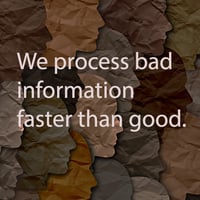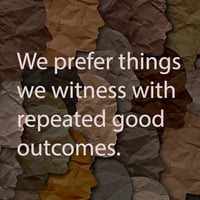Leveraging the Human Element for a Successful FAIR Risk Management Program, Part 1

 We wear a lot of hats as we’re building and managing risk programs. Here’s a few of them...
We wear a lot of hats as we’re building and managing risk programs. Here’s a few of them...
>>We’re managers of the organization’s risk register, ensuring it continues to bring value as an effective forecasting tool to help keep everyone aligned on what matters most.
>>We’re quantitative analysts who understand, normalize, and employ the concept of using measurements on an appropriate scale to reduce uncertainty and improve the quality of decisions.
>>We spend a considerable amount of time as evangelists, advocating for the value our programs provide and motivating people to follow us into the risk management promised land.
>>We should even be playing the role of scientists, according to Adam Grant, doubting what we know, maintaining healthy curiosity about what we don’t know, and updating our beliefs when we’re presented with new information.
 Author Zach Cossairt is Information Risk Program Manager at Equinix and winner of the FAIR Business Innovator Award for 2021. Learn more about Zach.
Author Zach Cossairt is Information Risk Program Manager at Equinix and winner of the FAIR Business Innovator Award for 2021. Learn more about Zach.
The FAIR Institute welcomes blog post contributions from our membership. Please contact us with your ideas!
Even with only this subset of what we do to influence the success of our programs, you can easily infer that it takes a certain kind of person to pull this off at any rate, let alone at an appreciable scale where we’re taught that our big ideas can change the world by reaching the largest number of people.
The kind of person who is successful building and scaling a risk program has another hat to wear. They have to wear the hat of an innovator. The role we execute as innovators carries with it the objective to heighten the appeal of something new and unfamiliar to our organizations and expect people to embrace change to successfully adopt it.
Framing Our Problem Space
Loran Nordgren and David Schonthal recently wrote a book called The Human Element that applies necessary rigor to decompose and analyze the significant challenge our over-arching goal as innovators represents. Their intent with this work is to alter the beliefs that many hold regarding what stimulates lasting adoption of an innovative idea.
They question the commonly held intuition that continuously adding to the appeal of an idea by highlighting its benefits and value, a fuel-based mindset as it’s referred to, is enough to draw people in and keep them coming back for more. Before we dig into the perceived limitations of this way of thinking, let’s take a look at why this somewhat superficial mentality remains the default option for approaching innovation.
Why We Think in Fuel
Would it surprise you if I said that it’s a deep-rooted human tendency that contributes to us embracing this approach to change management? If you happened to catch my talk at FAIRCON22, you might remember me talking about the human mind and its evolutionarily predisposed knack for cause-and-effect thinking. A fundamental attribution error leads us to habitually link undesirable events with deliberate intent.
We ask the question, “Why aren’t people from my organization seeking out my team’s quantitative risk services?” and instinctually we think that we must not have prompted enough optimism and enthusiasm to encourage our stakeholders to engage with us.
This Law of Attraction makes sense on the surface and of course this fuel is necessary to motivate people to make a change. However, we’re going to assume that you already know your idea is great and can sing like a canary when asked about the value a quant program can bring. My intent here is to focus more on the other half of the puzzle that needs to be solved in order for our new ideas to take flight. Here, I’ll be talking about friction.
Moving from Fuel to Friction
 Fuel is great. It provides the force needed to propel great ideas forward. But the friction generated by fuel is what our fellow humans first prioritize when considering whether to embrace a change. This is largely due to the evolutionarily advantageous negativity bias we all hold to varying extents, influencing us to allocate preciously limited cognitive capacity toward processing bad information faster than good. This was great for our ancient ancestors who were quite literally living to fight another day, but it’s an engrained part of our human element that impedes our ability to embrace innovation.
Fuel is great. It provides the force needed to propel great ideas forward. But the friction generated by fuel is what our fellow humans first prioritize when considering whether to embrace a change. This is largely due to the evolutionarily advantageous negativity bias we all hold to varying extents, influencing us to allocate preciously limited cognitive capacity toward processing bad information faster than good. This was great for our ancient ancestors who were quite literally living to fight another day, but it’s an engrained part of our human element that impedes our ability to embrace innovation.
The rest of this post will explore the first of four frictions acting as headwinds against our new initiatives that often go overlooked. I’ll relate Nordgren and Schonthal’s useful insights to what we can practically do as innovators to overcome these frictions as we build, scale, and directly contribute to our risk programs.
The First Friction: Inertia - Prioritizing the Familiar
Inertia is a friction acting against innovation as a powerful force enticing us to stick with the present situation and show reluctance to drift too far from what’s familiar. As humans, we apply more decision weight, and therefore give greater priority, to what we know than what we don’t. This made sense for our ancestors, who found it beneficial to avert the unproven and the uncertainty it produced, as it created a potential for loss that was best avoided to allow for the most promising opportunity to pass along their genes. Flash to today where this basic assessment, as Daniel Kahneman describes it, still takes place to promote a sense of cognitive ease associated with the familiar and a biological tendency to escape the uncertainty that accompanies change.
Additional fuel alone won’t alleviate this resistance to change, but there are a few bigger concepts and related tactics that can help innovators alter the perception of our ideas in a favorable way.
Tactic: Acclimating the Idea
 How big of a jump are we asking people to make? Do they have time to adjust to the new way of thinking? Is the change we’re proposing gradual, or a rapid alteration in thinking and practice? We can expect opposition to embracing change when those exposed to it haven’t received adequate time to adapt before being asked to buy-in.
How big of a jump are we asking people to make? Do they have time to adjust to the new way of thinking? Is the change we’re proposing gradual, or a rapid alteration in thinking and practice? We can expect opposition to embracing change when those exposed to it haven’t received adequate time to adapt before being asked to buy-in.Here are a few tactics with examples that can generate practical use of this concept as a FAIR practitioner.
Repeated exposure: The mere exposure effect tells us that we tend to develop preferences for things we witness repeatedly that do not result in negative consequences.
How to practically apply this tactic:
Frequently expose stakeholders to the concept of effective risk management grounded in valid quantitative measurement to reduce their uncertainty and increase familiarity by removing novelty from the idea. This also assists with easing interpretation by improving understanding of topics considered to be complicated at first.
Small strides to win the race: The familiar adage “don’t boil the ocean” applies to more than just advising not to overwhelm a small risk team. The status quo is a familiar reference point from which changes are inherently evaluated as concessions, and therefore losses. The human tendency to avoid losses makes the gains provided by an innovative idea seem small relative to the loss of the hard work put into the current state. This asymmetry influences us to stay put, even when there is acknowledgement of the inferior status quo.
How to practically apply this tactic:
>>Offer incremental exposure to your program’s outputs, presenting what us practitioners know is a radical change as a series of more manageable events.
>>Provide outputs sooner and with more value than what stakeholders expect to encourage a steady reinforcement through the anticipation of reward.
 Tailor to a prototype: There are both quantitative and qualitative forms of risk management and, as much as we are all doing our part to change the norm, softer methods are still what typically come to peoples’ minds in the field of security. Rather than focusing so much on what will be different when influencing change, you can highlight what will stay the same to supplement the unknown with a dose of familiarity. It takes more mental effort to understand things that don’t align with a prototypical standard and people are generally uninterested in doing more than what is required to accomplish a task. Pro tip: Don’t fight human nature.
Tailor to a prototype: There are both quantitative and qualitative forms of risk management and, as much as we are all doing our part to change the norm, softer methods are still what typically come to peoples’ minds in the field of security. Rather than focusing so much on what will be different when influencing change, you can highlight what will stay the same to supplement the unknown with a dose of familiarity. It takes more mental effort to understand things that don’t align with a prototypical standard and people are generally uninterested in doing more than what is required to accomplish a task. Pro tip: Don’t fight human nature.
How to practically apply this tactic:
>>Promote and utilize the simple one-for-one substitution model offered by Douglas Hubbard and Richard Seiersen that easily replaces the steps commonly used to generate the familiar risk register and qualitative risk matrix.
>>Concerns for the use of probabilities and loss range estimates will inevitably arise. When they do, it helps to explain the commonality of eliciting judgments of likelihood and impact regardless of the flavor of the risk management method.
>>Express the changes associated with gathering subject matter expert estimates as those addressing shortcomings of the prototypical standard (i.e., reducing noise and improving judgment accuracy by removing the ambiguity presented by words and phrases on an ordinal scale.)
Context Dependency
Would you drive 5 minutes across town to save 2 bucks on a gallon of gasoline? How about if a salesclerk told you that the expensive television you were about to purchase is 2 dollars cheaper just 5 minutes down the road? Would you make that trip? Individual differences exist of course but it is likely that, on average, people would travel to save on the gas but stay put when purchasing the TV.
This thought experiment describes a well-known but often under-appreciated truth about the world and how we perceive it: It’s all relative. We don’t see people, hear noises, feel temperatures, or forecast the reward we’ll receive from new ideas in a vacuum. Our preferences depend on the context from which they’re considered and factors that, although would be irrelevant in an Econ’s rational model of decision-making, are routinely taken into account when us humans make choices.
Our mind’s dopamine system hasn’t set us up to choose things in absolute terms, but instead by the relative reward value of available options. This means as we’re lobbying to assist in solving our organizations’ risk management problems, the value of the innovations we present is being implicitly estimated compared to one another and that of the status quo. This can prove troublesome for us because if there’s one thing we’ve learned it’s that the comfort of the current situation will likely be preferred over the new and unfamiliar. There’s hope for us innovators though, as the following tactics can be utilized to enhance the point of comparison of new ideas and reduce the friction stemming from a bias for the familiar.
 Join the FAIR Institute as a Contributing Member, enjoy exclusive networking and education opportunities. Join now.
Join the FAIR Institute as a Contributing Member, enjoy exclusive networking and education opportunities. Join now.
Pitch more than one potential (but favorable) solution: If the decision you’re presenting is whether to simply go quant or not, then inertia is going to make your life needlessly difficult. You can detract attention from merely comparing your idea to what’s familiar and comfortable by presenting multiple ways that the risk management problem can be solved.
How to practically apply this tactic:
· Introduce multiple solutions with varying resource requirements, tangible costs, and technology demands (i.e., pre-made one-for-one substitution spreadsheet vs. FAIR-U analysis framework vs. automated and scalable risk modelling solution.)
Make one solution an extreme option: Including a solution that might exceed what you know your organization is capable of adopting is another way to utilize the science of relativity in our favor. Changing the reference point to a more radical category makes our preferred solution by comparison seem like the center of the runway us humans notoriously seek to safely land our wheels on.
How to practically apply this tactic:
>>Be idealistic and highlight the optimal path you’d like your organization to take, regardless of whether you feel like it’s requesting too much. Even if the best option is considered to be out of the question, this can make the good enough solution seem relatively less threatening.
Summary
I was having a great conversation with a colleague the other day when she made the observation that there’s a somewhat entrenched belief in our industry that if we build risk programs for people then they will use them because, why wouldn’t they? We agreed with one another that it’s time to update this belief.
To reiterate: Fuel is instrumental to our success. But with a shift in focus from fuel to friction, we can enable an alternative perspective to help detect what may be hiding below the surface, producing drag on the positive change we strive to create.
This blog post was the first in a series of four meant to bring light to the frictions that should be more closely scrutinized and addressed if we want to accelerate the time to market of our innovative solutions that provide better decision tools at scale for widespread use.









